Resin infiltration treatment.
Trattamento di infiltrazione con resina.
According to WeRestore team this procedure is sometimes effective, sometimes not. We still need more time to test and understand this promising material. The main reason for insuccess is a huge thickness of “white spots” lesions. In that situations burs have to be used and a less conservative treatment has to be performed. In the other clinical situations seems working good.
L’opinione del team WeRestore è che questa procedura talvolta è molto efficace, in altre situaizoni meno. Quando non funziona spesso il motivo è da imputare ad uno spessore elevato delle lesioni bianche. Abbiamo bisogno di tempo per provare l’efficacia di questo materiale che sembra essere promettente. In quelle situazioni le lesioni devono essere preparate con le frese e un trattamento meno conservativo si rende quindi necessario. Nelle altre situazioni è una procedura che sembra dare buoni risultati.
This case instead had not so “thick” lesions. We have 1 year recall.
Questo caso invece non presentava lesioni troppo spesse.
Using an acid gel we make the “enamel peeling” in order to open the enamel porosities. With the alcool solution we can test the capacity of the penetration of the resin that we will use in the final step. It is possible to perform the acid procedure a couple of time. If after this it does not work, we should prepare the lesions with burs.
Utilizzando l’acido è come se facessimo una specie di “peeling” al fine di aprire porosità nello smalto. Con l’alcool possiamo testare la capacità della resina di infiltrare la lesione demineralizzata. E’ possibile ripetere l’applicaizone di acido 2-3 volte. Se questo non funziona dovremmo usare le frese.

Clinical case of hypomineralization of 1.1 and 2.1. The resin infiltration technique was choosed because of its mini-invasive approach.
Caso clinico con ipomineralizzazione su 1.1 e 2.1. E’ stata tentata la tecnica di infiltrazione con resina dal momento che risulta essere una tecnica molto conservativa.
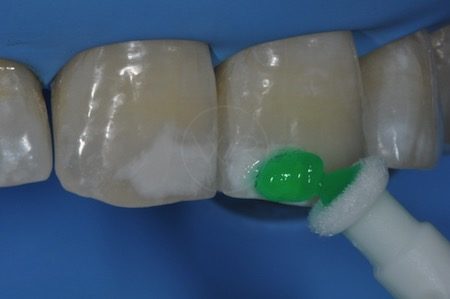
After a correct isolation with rubber dam and cleaning procedures of the teeth, the first step is the “enamel peeling” to improve the exposure of the enamel porosity.
Dopo l’isolamento con diga di gomma e una pulizia delle superfici, il primo passo è l’applicazione dell’acido. Questa fase assomiglia ad una specie di “peeling” dello smalto e ha lo scopo di aprire le porosità nello smalto.
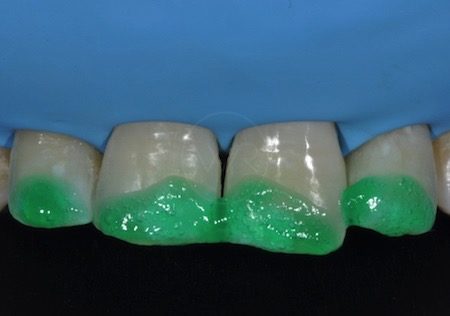
We brush for 2 minutes the acid agent on the lesions
L’acido viene agitato per 2 minuti
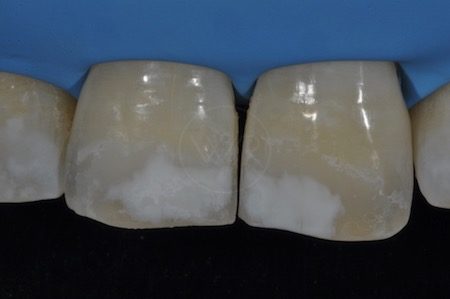
Rinse with water for 30 seconds and then dry the dental surfaces. The aspect of the enamel after the acid.
L’acido viene risciacquato per 30 secondi e le suprefici vengono asciugate.

Apply for 30 seconds an alcohol solution for visual inspection and then dry the surfaces. The opaque lesion discolorations must diminish significantly when we apply the alcohol, otherwise we must repeat the acid treatment, maximum 2 or 3 times.
L’applicazione per 30 secondi della soluzione di alcool permette di previsualizzare l’effetto finale. Se le lesioni scompaiono significativamente si puo’ passare all’applicaizone della resina. Altrimenti si deve ritornare all’applicazione dell’acido.
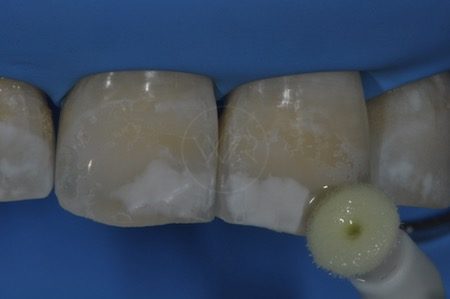
When the opaque lesion diminish with alcohol it means that we can dry the alcohol to apply the resin infiltrant for 3 minutes.
Nel caso di diminuzione delle lesioni si passa all’infiltrazione della resina che procede per 3 minuti.
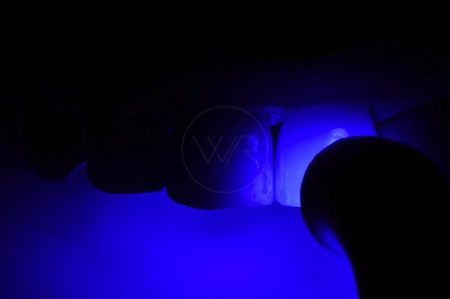
We remove the excess of resin using air and floss and then we light-cure for 40 seconds.
Dopo aver rimosso gli eccessi con aria e filo interdentale polimerizziamo per 40 secondi.
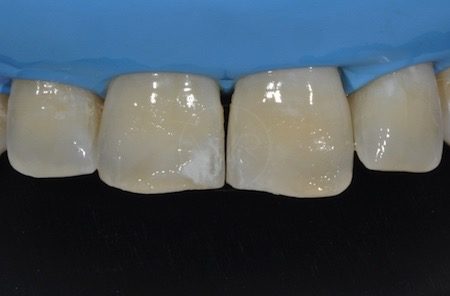
Re-apply the resin infiltrant brushing for 1 minute. Light-cure for 40 seconds.
Repplichiamo la resina per 1 minuto strofinando. Ulteriore polimerizzazione per 40 secondi.
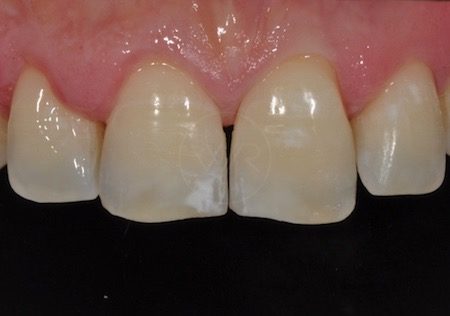
Immediately post-operative aspect after polishing.
Risultato dell’immediato post-operatorio.
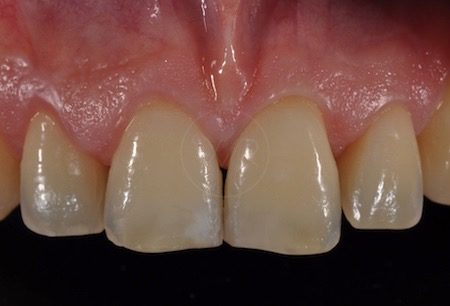
The aspect of the lesion 1 year recall
L’aspetto della lesione ad 1 anno.
The patient was more than happy and refused to treat the residual white lesion on #1.1
Il paziente era più che contento e non ha voluto procedere all’ulteriore eliminazione della lesione residua su 1.1.
If you like it share it on facebook with the buttons below!!
Se ti è piaciuto condividi sui social con i pulsanti qui sotto!!
Do you wanto to be NOTIFIED when a similar article is available? Subscribe below!
Volete essere avvertiti quando esce un nuovo articolo? Iscrivetevi qui sotto!

